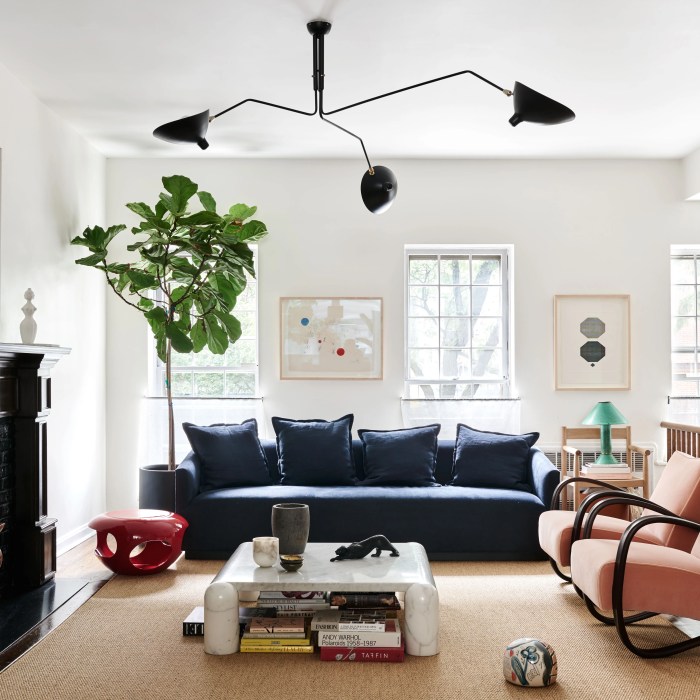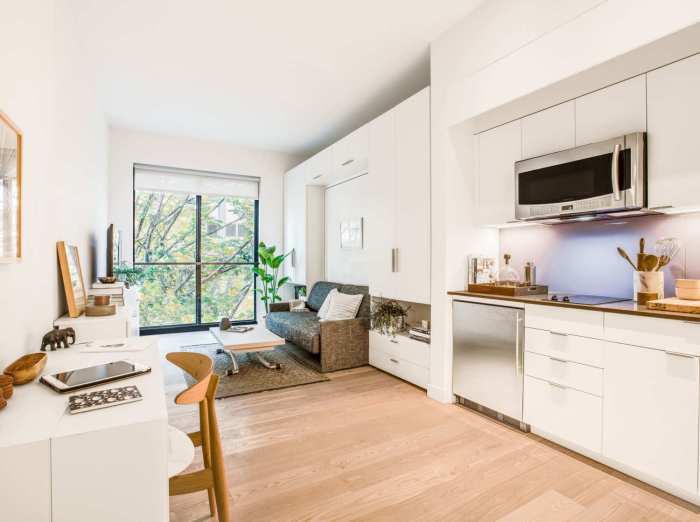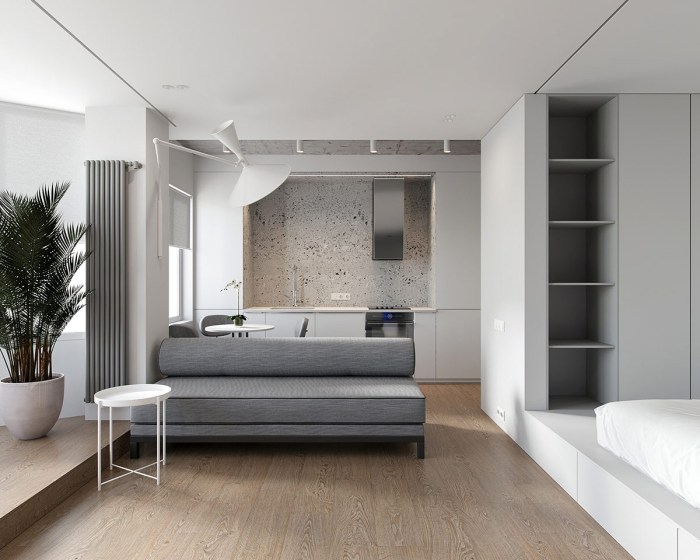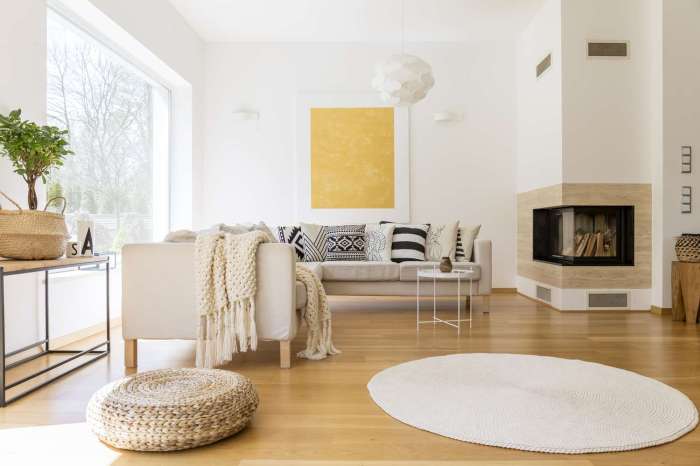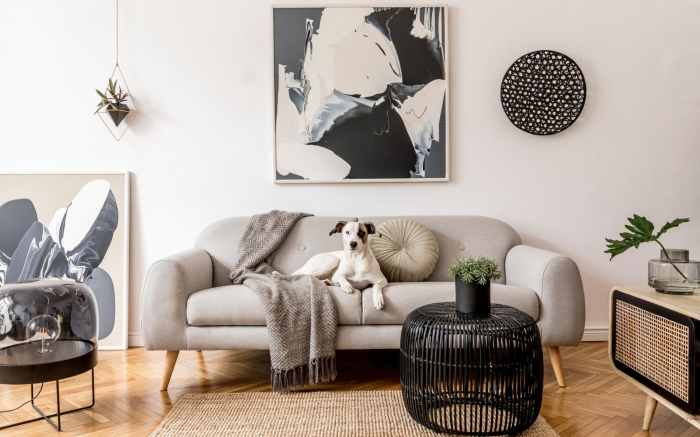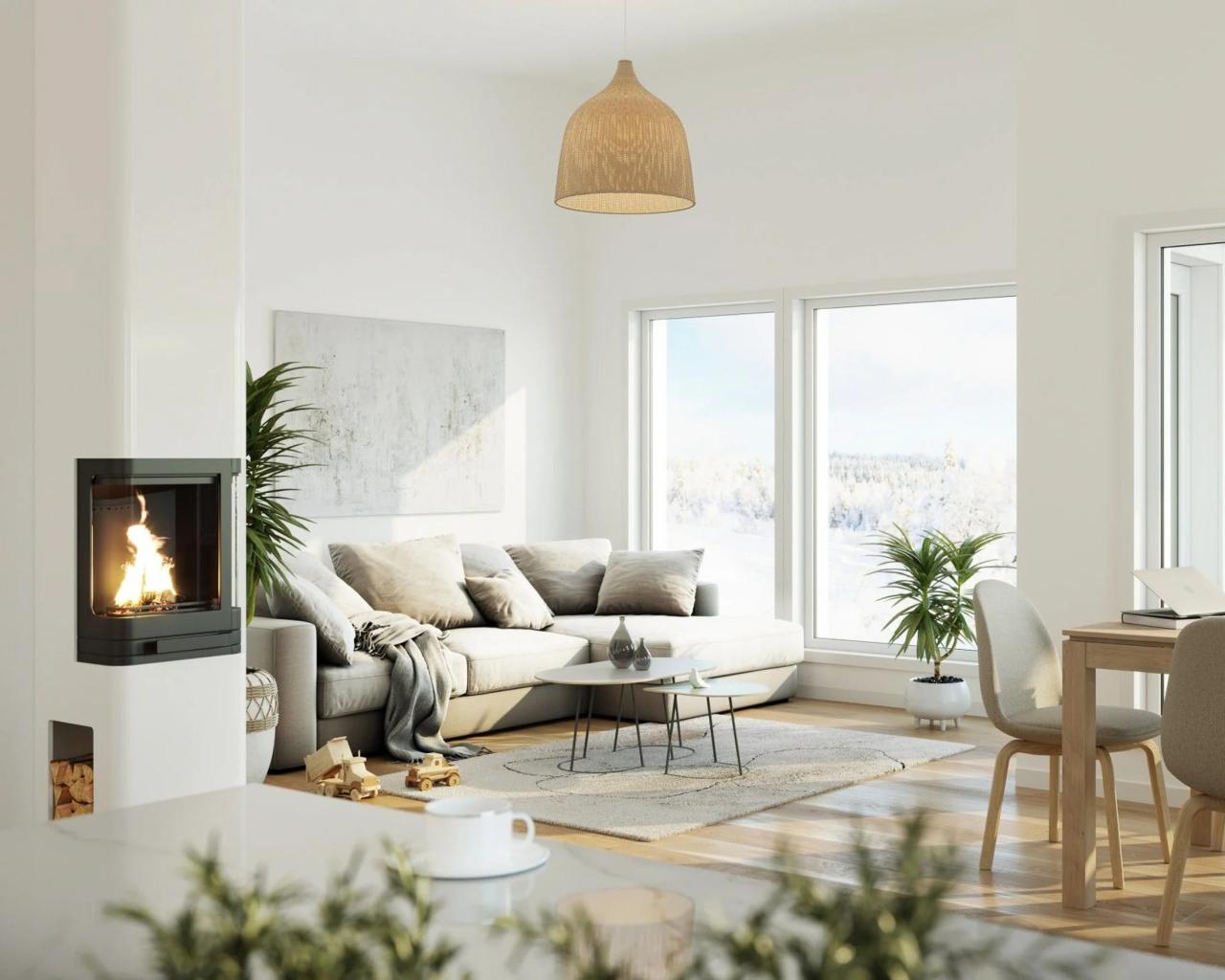Imagine a space where serenity meets sophistication. This exploration delves into the captivating world of minimalist home decor infused with the warmth and natural beauty of wood accents. We’ll journey through the principles of minimalist design, uncovering how strategic wood integration elevates aesthetics and functionality. From carefully curated color palettes and material selections to thoughtful furniture placement and DIY projects, we’ll unravel the secrets to creating a haven that’s both visually stunning and deeply calming.
The science of spatial design, coupled with the tactile appeal of wood, creates an environment that resonates with both the mind and the senses.
This journey will cover the selection of appropriate wood types – from the lightness of oak to the richness of walnut – and their impact on the overall ambiance. We’ll examine the interplay of different wood finishes, exploring how stained, natural, or whitewashed wood can dramatically alter the mood of a room. The exploration will extend to the careful consideration of complementary materials like concrete, linen, and metal, showcasing how these elements contribute to a cohesive and harmonious design.
Ultimately, we aim to provide a practical guide to transforming your living spaces into sanctuaries of calm and style.
Defining Minimalist Home Decor with Wood Accents
Minimalist design prioritizes functionality, simplicity, and intentionality. It’s a philosophy that advocates for removing clutter and focusing on essential items, creating a sense of calm and spaciousness. This aesthetic, often characterized by clean lines and a neutral color palette, can be significantly enhanced by the strategic incorporation of wood accents. The warmth and natural texture of wood offer a counterpoint to the often stark minimalism, adding depth and visual interest without disrupting the overall sense of order.The strategic use of wood accents elevates minimalist design by introducing a tactile and visually appealing element.
Wood’s natural variations in grain and color provide a subtle textural contrast against the smooth surfaces commonly found in minimalist spaces. This contrast creates visual interest without overwhelming the clean lines and uncluttered aesthetic. Furthermore, wood’s inherent warmth contributes to a more inviting and comfortable atmosphere, mitigating the sometimes perceived coldness of purely minimalist interiors.
Types of Wood Suitable for Minimalist Decor
The selection of wood type is crucial for maintaining the minimalist aesthetic. Woods with clean, consistent grain patterns and subtle color variations are generally preferred. Avoid woods with overly busy or dramatic grain patterns, as these can clash with the minimalist principle of simplicity.
- Light-colored woods: Ash, birch, and maple offer a clean, bright aesthetic that complements light-colored minimalist palettes. Their relatively straight grain patterns contribute to a sense of order and tranquility. Imagine a light oak coffee table with clean, simple lines, perfectly complementing a pale grey sofa and white walls.
- Medium-toned woods: Walnut and cherry provide a slightly warmer tone than lighter woods, adding a touch of richness without overwhelming the space. The subtle variations in their grain patterns offer visual interest without being overly distracting. A walnut shelving unit, for instance, could house a carefully curated collection of books and objects, each chosen for its aesthetic value and functionality.
- Dark-colored woods: Ebony or wenge, while less commonly used in minimalist settings, can be incorporated sparingly as statement pieces. Their deep, rich tones add a sophisticated touch, but should be used judiciously to avoid overwhelming the space. A single, dark wood accent chair, for example, could serve as a striking focal point in an otherwise light and airy room.
Benefits of Incorporating Wood in a Minimalist Space
Beyond its aesthetic appeal, incorporating wood into a minimalist design offers several practical and psychological benefits.
- Enhanced Warmth and Texture: Wood introduces a natural warmth and tactile element, counteracting the potential coldness of a purely minimalist aesthetic. The subtle variations in grain and color add visual interest and depth without cluttering the space.
- Improved Acoustics: Wood possesses sound-absorbing properties, which can be beneficial in improving the acoustics of a minimalist space, often characterized by hard surfaces that can amplify noise.
- Durability and Longevity: High-quality wood is a durable and long-lasting material, aligning with the minimalist philosophy of investing in quality pieces that will stand the test of time. A well-maintained wooden piece can last for decades, reducing the need for frequent replacements.
- Sustainability: Choosing sustainably sourced wood contributes to environmental responsibility, a value often shared by those who appreciate minimalist design’s focus on intentionality and reducing consumption.
Color Palettes and Material Choices
Minimalist design, while seemingly simple, relies on a sophisticated understanding of color theory and material interactions to create a space that is both visually appealing and emotionally resonant. The careful selection of a limited color palette and complementary materials is crucial for achieving the desired sense of calm and spaciousness. Wood, with its inherent warmth and natural variations, serves as a foundational element, influencing the overall aesthetic.The judicious use of color and texture is key to preventing a minimalist space from feeling sterile or monotonous.
Neutrals form the backbone of a minimalist color scheme, but strategic accents can inject personality without disrupting the overall sense of order. The interplay between light and shadow, as influenced by material choices, also significantly impacts the perceived atmosphere.
Neutral Color Palettes with Wood Accents
A minimalist space with wood accents often employs a neutral color palette, drawing inspiration from nature. Think muted creams, soft greys, and subtle beige tones. These colors provide a backdrop that allows the natural grain and color variations of the wood to take center stage. The addition of a single accent color, such as a deep teal or a soft sage green, can introduce a pop of personality without overwhelming the minimalist aesthetic.
For instance, a deep teal velvet sofa against a backdrop of creamy walls and light oak flooring creates a visually stunning and balanced contrast. The color psychology behind this choice is rooted in the calming effects of natural tones and the subtle vibrancy of the accent, promoting relaxation and a sense of tranquility.
Impact of Different Wood Finishes
The finish applied to the wood significantly alters its visual impact and the overall ambiance of the room. A natural wood finish, showcasing the inherent grain and color variations, creates a rustic and organic feel. This choice emphasizes the natural beauty of the wood and often pairs well with other natural materials like linen and stone. Conversely, a stained wood finish, such as a dark walnut or ebony, introduces a more dramatic and sophisticated element.
This can add depth and richness to the space, particularly when contrasted with lighter-colored walls and furnishings. Whitewashed wood, on the other hand, provides a lighter, airier feel, ideal for smaller spaces or rooms with limited natural light. The subtle, bleached appearance of whitewashed wood allows it to blend seamlessly with other light-colored elements while still maintaining a textural interest.
Material Combinations for Minimalist Spaces
Several materials complement wood in a minimalist setting, enhancing the overall aesthetic and textural richness. Concrete, with its industrial yet sleek aesthetic, offers a stark contrast to the warmth of wood. The combination of these two materials creates a balanced and sophisticated space, blending organic and industrial elements. Linen, a natural fiber with a soft and tactile quality, adds a touch of warmth and comfort, softening the potential harshness of concrete or metal.
Metal, particularly in matte black or brushed steel finishes, introduces a modern and refined element. The clean lines and metallic sheen of metal create visual interest and contrast against the organic texture of wood. These materials, carefully selected and combined, contribute to the overall harmony and visual balance of the minimalist design.
Furniture Selection and Placement

The successful implementation of a minimalist aesthetic with wood accents hinges on careful furniture selection and strategic placement. Overcrowding negates the core principles of minimalism, while poor placement can hinder both functionality and the visual harmony of the space. Understanding the principles of spatial design is crucial for achieving a balanced and inviting atmosphere. The choice of furniture pieces should reflect both practicality and aesthetic coherence, complementing the overall design scheme.Furniture placement directly impacts the perceived size and flow of a room.
Strategic arrangement can create the illusion of more space, enhance natural light penetration, and facilitate smooth movement throughout the area. Conversely, poorly placed furniture can make a room feel cramped and disjointed, hindering its usability and aesthetic appeal. The principles of proxemics, the study of spatial relationships between individuals and their environment, can be applied here to ensure comfortable and functional layouts.
Furniture Selection for Minimalist Spaces
Minimalist design favors functionality and clean lines. Suitable furniture pieces are characterized by their simplicity, often featuring uncluttered designs and natural materials. Key pieces for a minimalist living space with wood accents include a sofa (ideally a low-profile design), a coffee table, a few carefully selected armchairs or ottomans, and perhaps a media console or shelving unit. In the bedroom, a bed frame, a bedside table, and a dresser suffice.
Dining rooms require a dining table and chairs, maintaining a focus on simplicity and clean lines. The choice of wood type and finish will further enhance the overall aesthetic.
Optimizing Space and Flow Through Furniture Placement
Effective furniture placement maximizes space and flow by considering several factors. First, leaving ample space between furniture pieces allows for easy movement. Secondly, positioning furniture to maximize natural light enhances the spaciousness of a room. Thirdly, creating visual focal points using strategic furniture placement draws the eye and guides the flow of movement within the space. For instance, placing a sofa opposite a window allows for optimal natural light exposure and creates a natural focal point.
Avoid obstructing doorways or walkways, ensuring easy navigation throughout the room.
Furniture Arrangements for Different Room Types
A living room might feature a sofa against a wall, with a coffee table centrally placed and armchairs flanking either side. A bedroom might position the bed as the focal point, with bedside tables on either side and a dresser against an adjacent wall. A dining room’s arrangement centers on the dining table, with chairs placed around it, leaving enough space for easy access and movement.
These arrangements are merely examples; the specific layout will depend on the dimensions and features of each room.
Furniture Items and Wood Type Suggestions
The following table suggests suitable wood types and finishes for different furniture pieces, considering durability and aesthetic appeal within a minimalist context. The selection of wood type will depend on personal preference and budget, but it is essential to consider the environmental sustainability of the wood source.
| Furniture Item | Wood Type | Finish | Notes |
|---|---|---|---|
| Sofa Frame | Oak | Natural Oil | Durable and aesthetically pleasing |
| Coffee Table | Walnut | Clear Lacquer | Rich color and easy maintenance |
| Bed Frame | Pine | Natural Stain | Cost-effective and versatile |
| Dining Table | Maple | Satin Finish | Elegant and easy to clean |
Incorporating Wood Accents in Different Rooms
The strategic integration of wood accents within a minimalist design framework offers a unique opportunity to enhance both the aesthetic appeal and the functional utility of a living space. The inherent warmth and natural texture of wood contrast beautifully with the clean lines and uncluttered aesthetic characteristic of minimalist design, creating a harmonious and inviting atmosphere. The following sections detail the application of this principle across various rooms within a home.
Minimalist Living Room with Wood Accents
A minimalist living room featuring wood accents might incorporate a low-profile, light-colored wooden coffee table as the central focal point. Its simple, geometric design would complement the clean lines of a neutral-toned sofa and armchairs. A long, narrow wooden shelf mounted on the wall could display a curated collection of books or decorative objects, maintaining a sense of order and visual balance.
The use of light-colored wood, such as ash or birch, helps to maintain a sense of spaciousness and prevent the room from feeling overly cluttered. The natural grain of the wood adds a subtle textural element that enriches the overall visual experience without detracting from the minimalist aesthetic. Indirect lighting, perhaps from floor lamps with wooden bases, would further enhance the warm, inviting ambiance.
Wood Accents in a Minimalist Bedroom
In a minimalist bedroom, wood accents serve both aesthetic and functional purposes. A platform bed frame crafted from light oak or maple wood provides a clean, uncluttered base for bedding. Built-in wooden shelving, recessed into the wall, offers discreet storage solutions while maintaining a streamlined aesthetic. A small, wooden bedside table with a single drawer provides a practical surface for a lamp and personal items.
The choice of wood should be consistent throughout the room to maintain visual harmony, and a matte finish would complement the minimalist design. The subtle grain of the wood adds a touch of warmth and natural beauty to the otherwise simple space, promoting a calming and restful atmosphere conducive to sleep.
Wood Accents in a Minimalist Kitchen
A minimalist kitchen can benefit significantly from the strategic incorporation of wood accents. Wooden countertops, perhaps made from sustainably sourced bamboo or maple, offer a durable and aesthetically pleasing alternative to traditional materials. Wooden shelving, integrated into the cabinetry, provides ample storage space for cookware and utensils while maintaining a clean, uncluttered look. Wooden cutting boards and serving trays, used as functional items, add subtle yet visually pleasing accents.
The choice of wood should be carefully considered to ensure its resistance to moisture and stains, making it practical for kitchen use. A light-colored wood would help to brighten the space and prevent it from feeling dark or cramped.
Minimalist Bathroom with Wood Accents
A minimalist bathroom featuring wood accents would emphasize natural textures and a calming atmosphere. A vanity made of light-colored wood, such as birch or ash, with a simple, minimalist design would be the focal point. The wood should be treated with a water-resistant sealant to ensure its longevity and durability in a high-moisture environment. A wooden shelving unit could provide storage for toiletries and towels.
The use of matte-finished wood would prevent the space from feeling overly glossy or sterile. The inclusion of natural stone elements, such as a marble countertop or a tiled shower floor, would complement the wood accents and enhance the spa-like atmosphere. The overall design aims for a balance between functionality and aesthetic appeal, reflecting the principles of minimalist design while incorporating the warmth and natural beauty of wood.
Lighting and Decor
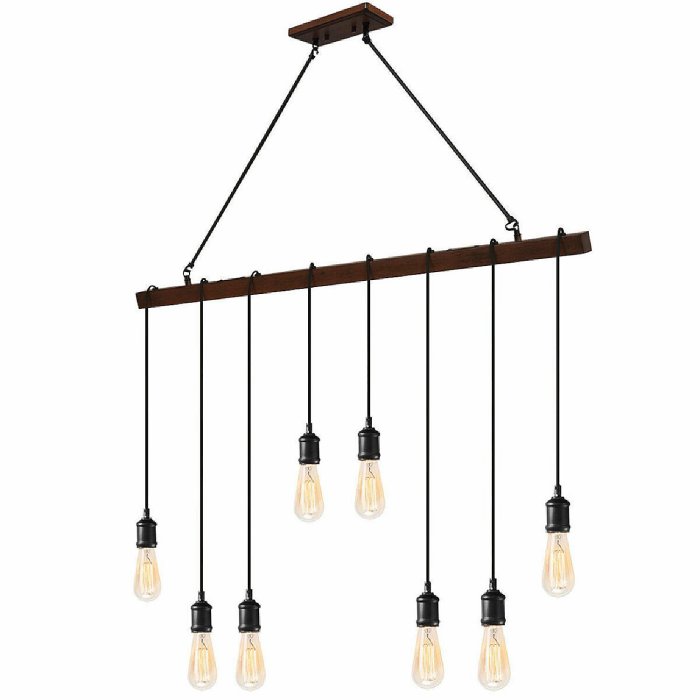
Minimalist design, characterized by its clean lines and uncluttered spaces, benefits significantly from a carefully considered lighting scheme and the strategic incorporation of decorative elements. The interplay of light and carefully chosen pieces creates an atmosphere of calm and sophistication, enhancing the inherent beauty of natural materials like wood. Effective lighting also serves a practical purpose, highlighting architectural features and creating distinct zones within the space.The successful integration of lighting and decor in a minimalist home with wood accents requires a nuanced approach, balancing functionality with aesthetic appeal.
Overly bright or harsh lighting can disrupt the serene ambiance, while insufficient illumination can leave the space feeling cold and uninviting. Therefore, a layered lighting approach, incorporating ambient, task, and accent lighting, is crucial for achieving the desired effect.
Ambient Lighting Strategies
Ambient lighting provides overall illumination, setting the mood and creating a welcoming atmosphere. In a minimalist space with wood accents, recessed lighting is a popular choice. Imagine softly diffused light emanating from recessed fixtures in the ceiling, casting a gentle glow across the room. This even distribution of light minimizes shadows and emphasizes the clean lines of the architecture.
Alternatively, strategically placed pendant lights above key areas like a dining table or kitchen island can provide both ambient light and a subtle design statement. The warm tones of a wood-framed pendant light, for example, would complement the overall aesthetic beautifully.
Task Lighting and Accent Pieces
Task lighting is essential for specific activities, such as reading or working. A sleek, minimalist desk lamp with a wood base would not only provide focused illumination but also add a touch of natural warmth to a workspace. Similarly, strategically placed floor lamps, particularly those with adjustable arms and wooden accents, can provide task lighting while maintaining a streamlined aesthetic.
Accent lighting, meanwhile, is used to highlight specific features or artwork. A small, adjustable spotlight aimed at a piece of wood sculpture or a framed photograph can dramatically enhance its visual impact, drawing the eye and adding depth to the space.
Minimalist Decor Items with Wood Accents
The selection of decorative items is paramount in a minimalist setting. Over-decoration can quickly negate the intended effect. However, carefully chosen pieces can add warmth, personality, and visual interest. Simple, functional items crafted from wood are ideal. A low, wide wooden coffee table provides a practical surface while contributing to the overall aesthetic.
Similarly, floating shelves crafted from light-colored wood offer practical storage solutions without cluttering the walls. These shelves can showcase a small collection of carefully chosen objects, such as a few books or a small plant, further enhancing the minimalist aesthetic. Wooden trays, picture frames, and even small wooden bowls can add subtle textural elements and visual interest without disrupting the clean lines of the design.
The key is to prioritize quality over quantity, selecting pieces that are both beautiful and functional.
Natural Light and its Importance
Natural light plays a vital role in creating a bright, airy, and inviting minimalist space. Maximizing natural light through large windows or skylights is essential. The natural light not only illuminates the space but also interacts with the wood accents, enhancing their warmth and texture. The way sunlight interacts with wood varies throughout the day, creating dynamic changes in light and shadow that add visual interest.
Moreover, natural light is linked to improved mood and well-being, making it an invaluable asset in any minimalist design scheme. Strategically placed mirrors can help reflect natural light deeper into the space, further maximizing its impact. This technique is particularly useful in rooms with limited natural light sources.
Avoiding Clutter While Maintaining Warmth and Personality
The essence of minimalist design lies in its intentional simplicity, prioritizing functionality and clean lines. However, this doesn’t necessitate a sterile or impersonal environment. The careful selection of a few well-chosen items, incorporating wood accents, can inject warmth and personality into the space without creating clutter. A carefully curated collection of books displayed on a wooden shelf, for instance, reflects the homeowner’s interests while adding visual interest.
Similarly, a single, striking piece of wood art can serve as a focal point, adding a touch of personality without overwhelming the space. The key is to curate items thoughtfully, ensuring each piece serves a purpose and contributes to the overall aesthetic. Regular decluttering is crucial to maintain the minimalist ethos and prevent the accumulation of unnecessary items.
DIY Wood Accent Projects
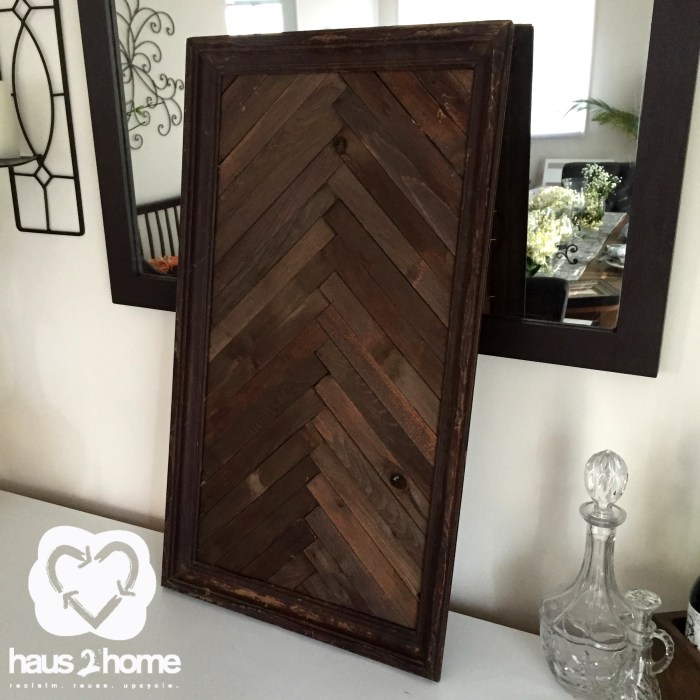
Embarking on DIY projects allows for the creation of unique, personalized minimalist wood accents, perfectly tailored to your home’s aesthetic. These projects utilize readily available materials and straightforward techniques, offering a satisfying blend of creativity and practicality. The following projects demonstrate how basic woodworking skills can transform simple materials into stylish and functional pieces.
Simple Minimalist Wooden Shelf Construction
Building a minimalist wooden shelf involves precise cuts and careful assembly. First, select appropriately sized planks of wood—consider pine or birch for their affordability and workability. Measure and cut the shelf’s support boards and the shelf itself to your desired dimensions using a miter saw for clean, accurate cuts. Sand all surfaces to a smooth finish, paying attention to edges to prevent splinters.
Apply a chosen finish, such as a clear sealant or a stain to enhance the wood’s natural grain. Finally, assemble the shelf by attaching the support boards to the wall using appropriate wall anchors, ensuring the shelf is level and securely mounted. The finished product is a sleek, functional shelf that adds a touch of warmth and practicality to any space.
Rustic Wooden Wall Art Piece Creation
Creating a rustic wall art piece involves repurposing reclaimed wood or using new wood with a distressed finish. Select a piece of wood with interesting knots or natural imperfections to enhance its rustic character. Sand the wood lightly to smooth any sharp edges. Consider adding a simple geometric design using a stencil and paint, or leave the wood’s natural texture as the focal point.
Alternatively, a single, carefully placed nail can add a touch of modern minimalist contrast. Once the design is complete, apply a protective sealant to preserve the piece and enhance its longevity. The finished piece is a visually appealing and uniquely textured addition to a minimalist wall.
Wooden Tray Organizer Fabrication
Constructing a wooden tray organizer for a desk or bathroom counter begins with selecting a type of wood and measuring the desired dimensions. For a simple design, cut four identical sides and a base from the chosen wood, ensuring clean, right-angled cuts. Assemble the sides and base using wood glue and small, inconspicuous nails or screws, ensuring the corners are perfectly aligned for a neat appearance.
Sand the assembled tray thoroughly, paying particular attention to the joints. Apply a protective finish—a clear coat is ideal for maintaining the natural wood appearance. This functional organizer is ideal for holding stationery, toiletries, or other small items, while adding a touch of organic elegance to any space.
Unique Wooden Lamp Base Development
Crafting a unique wooden lamp base involves careful selection of wood and creative design. A simple cylindrical base can be crafted from a single piece of wood, turned on a lathe for a smooth, polished finish. Alternatively, multiple smaller pieces of wood can be glued and assembled to create a more complex, geometric shape. Ensure that the chosen design incorporates a secure mounting point for the lamp’s electrical components.
Once the base is complete, sand it smooth and apply a finish that complements the overall aesthetic. The finished product is a handcrafted lamp base that adds a unique, personal touch to any room, demonstrating the versatility of wood in minimalist design.
Illustrative Examples
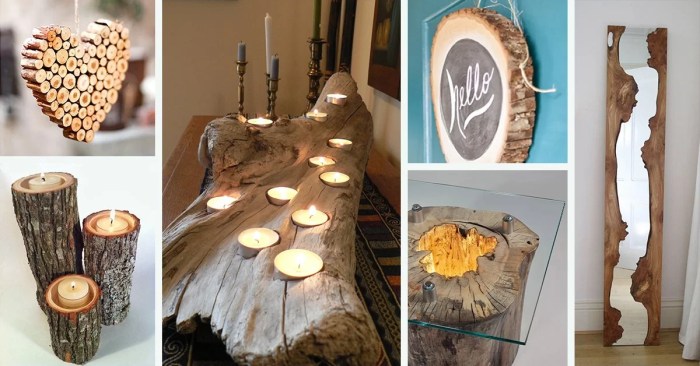
The following examples showcase how minimalist design principles, combined with carefully selected wood accents, can create diverse and inviting spaces. The interplay of light, texture, and material choices significantly impacts the overall mood and functionality of each room. These illustrations highlight the versatility of wood in minimalist interiors.
Minimalist Living Room with Light Oak Wood Accents
A minimalist living room featuring light oak wood accents exudes an airy and bright atmosphere. The pale, warm tones of the oak flooring, complemented by a light oak coffee table with clean lines, visually expand the space. The subtle grain of the oak, visible even under a soft, diffused light, adds a textural element without overwhelming the minimalist aesthetic.
A single, strategically placed light oak shelving unit displays a few carefully chosen objects, emphasizing negative space and showcasing the beauty of simplicity. The light oak contrasts beautifully with the crisp white walls and pale grey sofa, creating a harmonious and calming environment. The light reflectance properties of the oak contribute to the overall brightness, enhancing the feeling of spaciousness.
The texture of the oak, smooth to the touch yet subtly grained, adds a tactile dimension to the room’s visual appeal.
Minimalist Bedroom with Dark Walnut Wood Accents
In contrast to the bright living room, a minimalist bedroom with dark walnut wood accents creates a feeling of warmth and sophisticated coziness. The rich, deep brown tones of the walnut headboard, nightstands, and flooring anchor the space, grounding the overall design. The dark walnut’s dense grain, visible in the subtle variations of its color, adds a layer of visual interest.
The natural oils present in walnut wood contribute to its rich, warm hue and also enhance its durability. This warmth is further emphasized by the use of soft, textured linen bedding in muted tones. A single pendant light, positioned centrally above the bed, casts a soft glow, highlighting the beauty of the walnut wood. The dark wood’s ability to absorb light creates a more intimate and restful atmosphere, perfect for a bedroom.
The contrast between the dark wood and the lighter walls and textiles further enhances the sense of visual interest and depth.
Minimalist Kitchen with Bamboo Wood Accents
A minimalist kitchen incorporating bamboo wood accents seamlessly blends natural materials with modern design. Bamboo’s inherent lightness and sustainability make it an ideal choice for a minimalist aesthetic. The light, almost straw-like color of bamboo countertops and open shelving units creates a bright and airy feel. The straight grain of the bamboo adds a clean, linear element to the space, perfectly complementing the minimalist design.
The use of bamboo is not just visually appealing; it also adds a touch of eco-consciousness, reflecting a growing trend towards sustainable living. Bamboo’s natural antibacterial properties are a practical advantage in a kitchen environment. The incorporation of other natural materials, such as stone and linen, further reinforces the kitchen’s overall organic and minimalist character.
Minimalist Bathroom with Reclaimed Wood Accents
A minimalist bathroom featuring reclaimed wood accents showcases a striking contrast between old and new materials. The weathered texture and unique grain patterns of the reclaimed wood, perhaps salvaged from an old barn or building, add character and a sense of history to the otherwise modern space. The imperfections in the wood—knots, cracks, and variations in color—tell a story, adding a unique and rustic touch.
These imperfections are embraced as part of the design’s charm, highlighting the beauty of natural, aged materials. The reclaimed wood, perhaps used for a vanity or shelving unit, is juxtaposed against sleek, contemporary fixtures and tiles, creating a visually engaging tension between the old and the new. This combination creates a space that is both stylish and environmentally conscious, highlighting the potential of repurposed materials in minimalist design.
The contrast in texture—the smooth surface of the tiles against the rough texture of the reclaimed wood—adds further depth and visual interest.
By thoughtfully incorporating wood accents into a minimalist design, we achieve a harmonious blend of form and function. The result is a space that transcends mere aesthetics, becoming a reflection of personal style and a sanctuary for the soul. The strategic use of wood, coupled with a mindful approach to color, materials, and lighting, fosters a sense of tranquility and well-being.
This journey into minimalist design with wood accents underscores the power of simplicity and the enduring appeal of natural materials in creating a truly exceptional living environment. The scientific principles of spatial organization and the inherent beauty of wood converge to create spaces that are both visually appealing and deeply restorative.
Essential Questionnaire
What are some common mistakes to avoid when incorporating wood accents in a minimalist space?
Overdoing it! Too much wood can negate the minimalist aesthetic. Also, avoid using overly ornate or heavily carved wood pieces; stick to clean lines and simple designs.
How can I incorporate wood accents without making the space feel dark or heavy?
Opt for lighter wood tones like ash or maple, use whitewashed or light-stained finishes, and ensure ample natural light. Strategically placed mirrors can also help to brighten the space.
What are some affordable ways to add wood accents to my home?
DIY projects are a fantastic option! Consider building simple shelves, a wall-mounted coat rack, or even a decorative tray. Thrift stores and flea markets can also be great sources of affordable, unique wood pieces.
How do I choose the right wood type for my minimalist space?
Consider the overall style and color palette of your home. Lighter woods create a brighter, airier feel, while darker woods add warmth and depth. Durability and maintenance requirements should also be factored in.
Can I use reclaimed wood in a minimalist space?
Absolutely! Reclaimed wood adds character and a unique texture, complementing a minimalist aesthetic while promoting sustainability. Just ensure the wood is properly cleaned and treated.
